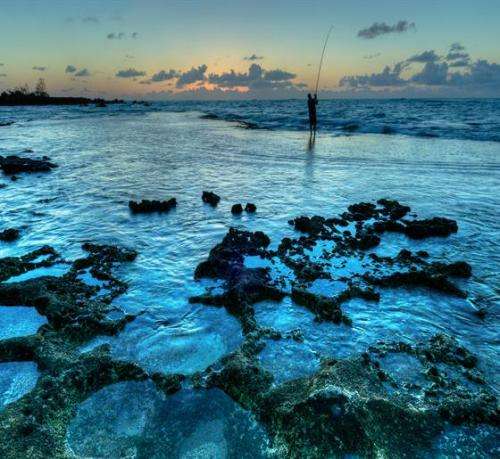Study finds two-thirds of Hawaiian reefs are covered with algae

According to a study published today in the Philosophical Transactions of the Royal Society – Biological Sciences, just one-third of the coral reefs ecosystems in Hawai'i are dominated by healthy corals and calcareous algae. The study, led by the Stockholm Resilience Centre, Stanford University's Center for Ocean Solutions, the University of Hawaii, NOAA, the Scripps Institute of Oceanography, and Conservation International-Hawai'i, also identified the key stressors of these reef systems, including declines in herbivorous fish abundance, ocean temperature and pollution run-off from land.
"While some algal cover is natural on Hawaiian reefs, it is unexpected to find that turf algae dominate more than half of all reefs we examined," said Jean-Baptiste Jouffray of the Stockholm Resilience Centre at Stockholm University. "This raises the question whether turf-dominated reefs are stable configurations or transitional states moving towards macroalgae or conversely towards coral recovery."
Coral reefs are among the most biologically diverse ecosystems on earth, and harbor approximately 25% of all marine species. They also provide a wide range of ecosystem goods and services that are crucial for economic and societal development, such as food, coastal protection and income from tourism. Coral reefs are of critical importance in Hawai'i, supporting near-shore fisheries. The average resident of Hawai'i consumes three-times as much seafood – up to 60% of which is imported - than other Americans. Healthy reef ecosystems can help restore the islands' seafood security.
Some of the healthiest corals in Hawai'i are in the remote northwestern Hawaiian Islands, where they are effectively conserved as part of the Papahānaumokuākea Marine National Monument. Identifying the healthy, natural condition of coral reefs is important for managers, seeking to protect the reefs and the ecosystem services they can generate.
"The condition of coral reefs around Hawaii is determined largely by the abundance of herbivorous fish," said Magnus Nyström, Associate Professor at the Stockholm Resilience Centre at Stockholm University. "Hence, keeping herbivore populations healthy should be of key concern for safe-guarding Hawaiian coral reefs. However, other human stressors such as land run-off, also seem to be important, especially for the occurrence of turf algae."
"This study tells us that there are tipping points for coral reefs, where even small increases in human stressors can impart major changes in the status of reefs," said Jack Kittinger, director of Conservation International-Hawai'i. "From a management perspective, understanding the safe operating space is critical, and these tipping points give us concrete milestones to shoot for to protect healthy reefs, recover reefs that are in decline, and increase the benefits that reefs provide to communities across our archipelago."
Journal information: Philosophical Transactions of the Royal Society
Provided by Conservation International




















